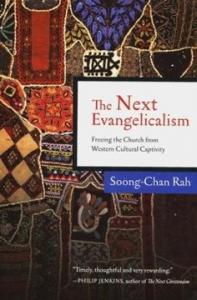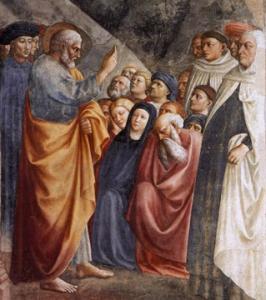The following post, the first in a short series on the book of Acts, was written by a Christian colleague (JAG) who teaches in the School of Social Work. Both his professional expertise and his personal experience as a second generation immigrant shape his understanding of the book and bring insights that will help all of us read the book better. He presented the material in a well received class at our church and I am pleased to bring it here as well. RJS
The church at Jerusalem (Acts 1-5) drew from a community that was intergenerational but ethnically Jewish, with diverse experiences varying with respect to language, place of residence, politics, and even religious tradition.
A Personal Introduction: What is Triple Consciousness?
 As the eldest son of immigrants from the Philippines teaching Social Work at a state university, the concept of triple consciousness is intertwined with many aspects of my personal and professional lives. In The Next Evangelicalism: Freeing the Church from Western Cultural Captivity (2009), Soon-Chan Rah first summarizes “double consciousness” from W.E.B Dubois’ The Souls of Black Folks. The American Negro must deal with “having to behave in a certain manner in society at large while behaving in another manner (maybe a more “natural” manner) in their own cultural setting.” (p 182). Rah then references the work of Hispanic American theologian Eldin Viillafane. Triple consciousness is the ability of “Second generation Latinos to live and work in majority culture…Second generation Latinos are also able to move among their parents’ generation (the immigrant generation).” (p 182). A third consciousness emerges in the ability these Latinos have in relating to their second generation peers. A second generation Korean American himself, Rah concludes, “The concept of triple consciousness applies to not only English-speaking second-generation Latinos but also to other second-generation immigrant communities.” (p 183).
As the eldest son of immigrants from the Philippines teaching Social Work at a state university, the concept of triple consciousness is intertwined with many aspects of my personal and professional lives. In The Next Evangelicalism: Freeing the Church from Western Cultural Captivity (2009), Soon-Chan Rah first summarizes “double consciousness” from W.E.B Dubois’ The Souls of Black Folks. The American Negro must deal with “having to behave in a certain manner in society at large while behaving in another manner (maybe a more “natural” manner) in their own cultural setting.” (p 182). Rah then references the work of Hispanic American theologian Eldin Viillafane. Triple consciousness is the ability of “Second generation Latinos to live and work in majority culture…Second generation Latinos are also able to move among their parents’ generation (the immigrant generation).” (p 182). A third consciousness emerges in the ability these Latinos have in relating to their second generation peers. A second generation Korean American himself, Rah concludes, “The concept of triple consciousness applies to not only English-speaking second-generation Latinos but also to other second-generation immigrant communities.” (p 183).
Growing up I vividly remember asking my parents about going camping – and being taken aback by their response.
Camp? What is wrong with this house? Sleep outside on the hard ground with no running water or air con? Why did we move here from the Philippines?
This prompted an ongoing series of three distinct discussion streams. Through extended conversations with my parents I gradually sketched a picture of their experiences during World War II. My Mom, in particular, was a young girl who spent her formative years hiding in the jungle, fleeing from the invading Japanese army – no wonder “roughing it” had so little appeal. A second stream was with my second generation peers. Did you have a similar experience talking about the American notion of camping with your immigrant parents? If so, what terms did you use? What cultural frames of reference were helpful? Is there a similar experience of camping in the Philippines? Would it be useful to mention “glamping”?
A third stream was with my peers whose parents were not Filipino. I grew up in a suburb of metropolitan Detroit, an area historians have described as segregated by race. Members of my family were often the only people of color in our neighborhood, our community, our church. So what portion of my Mom’s war stories do I choose to share with my white peers, if any? This continues as an issue, even today in higher education. Why is the burden so often on people of color to explain their experiences to the white majority? Or as one of my colleagues put it, administrators often argue that a diverse body of students and faculty is good because now we can educate white people about racism. Sometimes this thinking also seeps into church planning.
How Does this Discussion about Triple Consciousness Relate to Acts?
 Often the word “diaspora” is used to describe the migration patterns of Latinos, Koreans, Filipinos and other groups. It can also be applied to the “God-fearing Jews from every nation under heaven” in Acts 2:9-11.
Often the word “diaspora” is used to describe the migration patterns of Latinos, Koreans, Filipinos and other groups. It can also be applied to the “God-fearing Jews from every nation under heaven” in Acts 2:9-11.
“Parthians, Medes and Elamites; residents of Mesopotamia, Judea and Cappadocia, Pontus and Asia, Phrygia and Pamphylia, Egypt and the parts of Libya near Cyrene; visitors from Rome (both Jews and converts to Judaism); Cretans and Arabs—we hear them declaring the wonders of God in our own tongues!”
These verses describe devout Jews returning to Jerusalem to celebrate Pentecost, a religious holiday. Since they do not reside in Jerusalem but in other places within the Roman Empire, as with children of immigrants today, their first language or tongue is what is spoken in the places where they reside – places where Rah would say they need to “behave in a certain manner in society at large” because they exist so clearly on the margins and in the minority.
This marginalized existence, however, requires the development of triple consciousness as a coping mechanism for the realities of everyday life. I hasten to add that this consciousness, and the related abilities to switch back and forth between linguistic and cultural frames of references, is essential in moving forward Jesus’ charge in Acts 1:8.
“But you will receive power when the Holy Spirit comes on you; and you will be my witnesses in Jerusalem, and in all Judea and Samaria, and to the ends of the earth.”
In subsequent sections my thesis is these “God-fearing Jews from every nation under heaven” demonstrate triple consciousness. This will be clearer as we examine the ministries of the Seven Deacons, especially Stephen and Philip, and Paul. My emphasis on this second generation, however, should not be read as a slight of the first generation, identified as “Galileans” (Acts 2:8) and mainly represented in the first five chapters by Peter and John. Their contributions are the very foundations of the church today, a blueprint for all generations.
Is this Reading of Acts Meant Only for Children of Immigrants?
No. One theme of Acts is diversity, very much in the news today, especially in higher education. If diversity is defined, at least for now, as differences within as well as between social groups, then the church in Jerusalem as described in Acts 1-5 is diverse and while triple consciousness helps bridge both sets of differences, the related skills and competences can be developed with practice. The Questions for Reflection at the end of each post are prompts for readers to consider in the development of these skills and competencies.
Although the initial focus has been on diversity in terms of language and place of residence, the church at Jerusalem drew its membership from a Jewish community that was also divided by religious tradition and politics. Peter and John are brought before the Sanhedrin in Acts 3:1-9. This ruling council is comprised to two distinct groups – Acts 23:8 describes their varying religious traditions succinctly:
For the Sadducees say that there is no resurrection, nor angel, nor spirit, but the Pharisees acknowledge them all.
Additionally, the Jewish community is also split along political lines. In Jesus and the Disinheritied (1949) Howard Thurman poses “The urgent question was what must be the attitude toward Rome…in essence, Rome was the enemy…“…one may take the position of imitation. The aim of such an attitude is to assimilate the culture and social behavior pattern of the dominant group. It is profound capitulation to the powerful…Herod was an excellent example…(pp 12-13). “Armed resistance is apt to be a tragic last resort in the life of the disinherited…This was the attitude of the Zealots in Jesus’ day.” (pp 15-16)
To conclude, first, the early church drew from across the political spectrum in the Jewish community. Matthew, for example, was a hated because he worked as a tax collector, a job embodying a most “profound capitulation to the powerful.” Contrast this with lists of the Apostles that repeatedly identify one of Jesus’ closest associates as “Simon the Zealot” (Acts 1:13).
Second, with regard to the Sanhedrin, the outreach is across differences in religious tradition, to both Sadducees and Pharisees. All are invited to follow Jesus, even if the Pharisees prove to be more open.
Third, implicit in both my description of triple consciousness and Rah’s is an ability to bridge the so-called Generation Gap. In my Social Work classes I emphasize the importance of knowing family stories – how do the experiences of your parents and grandparents fit with whatever the topic is in a given class? I have been struck by how often students tell me they had never previously known the details of their parents’ or grandparents’ lives. I was particularly touched by this email from a former student, a full ten years after our last class.
I wanted to thank you for the final assignment, dialogue with an elder. I interviewed my Grandfather, who passed away a few months ago. I felt fortunate to have learned more about his life through my interview with him, and to be able to reflect on his life through the final paper. I still use some of the lessons learned from the class and appreciate you teaching us.
Questions for Reflection
When did you last have a meaningful conversation with someone:
- Whose first language was not English?
- From different faith tradition?
- Who disagrees with your politics?
- From your parents’ or grandparents’ generation?
- Who has lived in another state or country?
If you wish to contact me directly you may do so at rjs4mail [at] att.net.
If interested you can subscribe to a full text feed of my posts at Musings on Science and Theology.











